Farewell Wolfspitz!
About the extinction of a German cultural asset
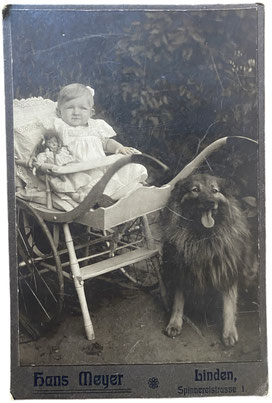
They come from Westphalia, the Wolfsspitzes, who have no resemblance to their namesake the wolf. They are loyal companions to humans, but they resist flattery; they are driven by extreme vigilance. The suspicious-looking, smooth face with upright ears always looks out from the thick lion's mane-like ruff around the neck. The medium-sized, square body is protected by a coat of hair so thick that neither annoying heat nor bitter cold, nor rain nor snow, can reach the bottom of the skin. They are tough fellows, our good old Wolfspitzes and like no other breed they are predestined as non-poaching farm and guard dogs. It seems almost striking when our Wolfsspitz stands at the wide open courtyard or garden gate, as if there was an invisible wall in front of him. Rabbits can hop close by, deer can pass by - the Wolfspitz pays no attention to them. Wolfsspitzes have a very original, primitive nature, they love a lot of freedom - they hate coercion - and are extremely close to nature. Many wolves can be...
But stop! Those times are long gone, and I should actually write my text in the past tense, because unfortunately nothing is as it once was. Because our Wolfspitz is gradually becoming extinct.
Why? The good all-rounder working dog named Wolfsspitz became a plush lover's dog due to the increasing focus on a supposed beauty in the last years. Fortunately, there are exceptions, which is why here and there are still good working dogs among the Wolfspitzes that have not been bred to have an appearance that the generous buyers from Italy, England, the USA or Holland reward so generously.
The first trick: the Wolfsspitz as a toy dog
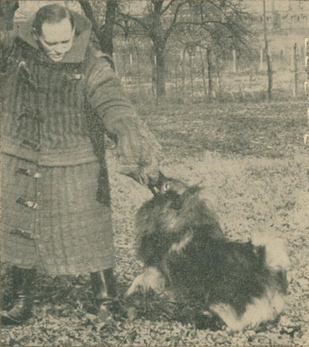
Our Wolfspitz were once found in FCI Category 2b: “Sheepdogs, guard dogs and protection dogs without a working test” until the idea came up to put them in FCI Category 9: “Companion and toy dogs”. That knocks the heaviest frog out of the pond! Toy dog! Rightly outraged club members ultimately ensured that the Spitz was demoted back to his old section - only to end up back with the toy dogs the following year. This constant back and forth took place between 1973 and 1979. Finally, at the instigation of the Swiss cynologist Dr. Hans Räber founded the FCI category 5: "Spitz and primitive dogs", in which the German Spitz has been represented since 1990. However, since being classified in the lapdog category, the Wolfspitz, which was once so popular as a service dog with the police and armed forces, has been unemployed, because "lapdogs" logically could not be used as service dogs in the executive branch - unless you wanted to make yourself a laughingstock.
If, on the other hand, the focus of breeding had remained on the original "all-rounder working dog", which could guard as well as herd, the breeding direction that I now have to criticize would not exist: you see so-called Wolfsspitzes at dog shows more and more often, which hardly more than such can be recognized. Hardly any color, but all the more fur, far too long backs, short, really thick legs - and recently in the color "stonewashed caramel" (a kind of washed out beige brown - a color that is not supported by the breed standard). Surprisingly, these dogs win prizes after prizes at the shows, even though they do not strictly meet the standard - neither in color nor in body type. For example, the standard clearly states that Wolfsspitzes must have weatherproof fur. However, it's strange that dogs that look like extruded cushions are in any way weatherproof. On the contrary, everything gets stuck in this fur and because it is as soft as cotton, it gets soaking wet when it rains. In addition, the standard describes a dog whose body shape must be square. However, the dogs at the shows sometimes look as if they were crossed from Corgis or Västgötaspets when it comes to the length of their backs!
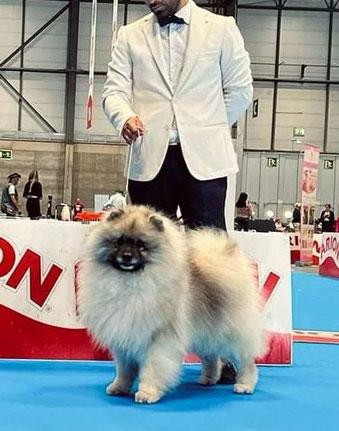
Now, what does that mean in plain language? That a celebrated show dog does not necessarily mean a good breeding dog. In addition, one cannot avoid the subjective impression that the winning Spitzes at the shows are distributed according to the handler's nose and not according to how closely the dog meets the desired breed standard. But the worst thing about it is that people who want to find out more about a certain breed at the big dog shows can no longer get to know and meet the original type. Either because he is not there or because he no longer exists. The shows have now mutated into pure beauty competitions, on the basis of which these highly prized champions are then bred. Due to his show success, a German champion stud dog has mated a total of 24 times since September 2016 and has 169 offspring as his own - that is 13.13% of all Wolfspitz litters that have fallen in the VDH (Germany) since 2016.
“Beautiful is what serves the purpose of performance”.
An old-fashioned saying. If breeders, judges and clubs adhered to this, we would have fewer problems with illnesses or character defects, would need less money for all the health examinations, but would have first-class, healthy working dogs. In this context, you have to ask yourself the question of how good and healthy a breed actually is, that requires countless health tests in order to prove the health of the individual dog.
It might make sense to hold beauty championships and breeding shows separately in the future. And perhaps it would also be helpful to think outside the box and take a cue from other professional breeding clubs.
The second trick: The integration of the Keeshond into the Wolfspitz's breed standard
While the FCI's classification as a lapdog was the first strike against our Wolfsspitz, the second one followed immediately in 1993, when it was decided to include the Keeshond into the standard of the Wolfsspitz. Since then, our Wolfspitzes have become increasingly smaller, plusher, more colorless and more short-muzzled. This becomes clear in these two videos from the “National Dog Show” from 2020 and 2022, in which Keeshonden are shown in the ring. I honestly don't know whether to laugh or cry at these caricatures of our old Wolfsspitz breed:
Of course, there are also a lot of beautiful Keeshonden with much color and good substance and just as many great dogs that have both Keeshonden and Wolfsspitzes in their pedigree, but the current breeding direction for Keeshonden is clear - especially when you look abroad. See a short journey through time in pictures from 1927 to 1992, which shows the trend in Keeshond breeding very well: from the wonderful guard dog to a kind of giant Pomeranian. I could cry! 😫
Keeshond up from 1927 (left) until 1992 (right)
Maybe in the future it would be better to keep the Keeshonden as a separate breed or variety in order to avoid the total "keesification" of our old Wolfsspitz lines? In my opinion, we could definitely think about it.
But the third one follows immediately: the mixing of Wolfspitz and Giant Spitz
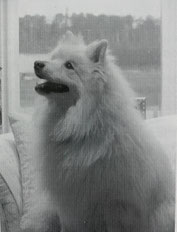
The third strike against our Wolfsspitz is currently in progress. In a brazen solo effort, the Dutch "Nederlandse Keeshonden Club" has presumed to generally allow the mating of Wolfspitz/ Keeshond and Giant Spitz: Varieteitskuising.
The Wolfsspitz is a very old German (!) dog breed - and not a Dutch, Czech or English breed. For this reason, Germany maintains the studbook and sets the standard for German Spitz, both at home and abroad. So what exactly happened that our dog breed was not just deprived of its name abroad ("Keeshond", "Pomeranian"), but that now in Germany we have to watch the Dutch doing whatever they want with our breed - in addition to the solo effort of the Czechs years ago?!? [3] Conversely, it'd be correct: all the other countries have to comply with our current standard for our dog breed!
We keep the studbook and we define the standard! And no one else. How would the Dutch like it if we single-handedly grew a stubby tail, curls and erect ears on their Kooikerhondje?
The German Spitz is an old dog of German folk and part of German cultural heritage. The solo effort of the Dutch Spitz Club is therefore not just brazen, but is simply cultural theft, i.e. cultural appropriation!
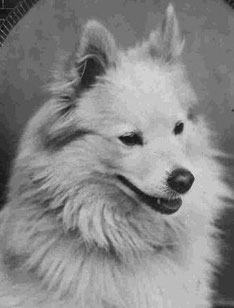
Don't get me wrong: There's nothing inherently wrong with crossbreeding a suitable Wolfspitz here and there into the population of the Giant Spitz in order to reduce inbreeding and increase diversity. Or to compensate for a lack of substance, or to soften the choleric severity of our Giant Spitz. This is definitely better than using other breeds for this. However, something like this should also be controlled by experts in terms of breeding in order to avoid a wild breeding chaos. Why? Wolfsspitzes and Giant Spitzes differ very clearly from each other in both their nature and appearance. The head shape of the Wolfsspitz alone stands out clearly from that of the Giant Spitz, as can be seen in the photos below.
However, the idea of leaving it to the individual breeder to decide which varieties can be mated with each other is absolutely crazy. As a rule, he neither has any knowledge of the anatomy or physiology of the Spitz that goes beyond the “cuddly” fur or color genetics, nor does he have any concrete knowledge of the Spitz’s specific characteristics. At this point, the German Spitz Club would actually be asked to intervene in the breeding, because the main areas of responsibility of a dog association are, on the one hand, public relations and, on the other hand, the sensible development of the cynology of the respective breed.
Mating Wolfsspitz and Großspitz or pure breeding?

The separation between Wolfspitzes and Giant Spitzes, which took place in 1965, had fundamentally justified reasons: people wanted to know what was being bred and what exactly was being thrown. To date, Wolfsspitz litters have produced Giant Spitzes and Giant Spitzes litters have bred Wolfspitzes. Or both at the same time. This was because during and after the Second World War, the Giant Spitzes and Wolfsspitzes were crossbred with each other in a relatively inflationary manner. In order to deal with this, it was decided to separate Wolfsspitz and Giant Spitz and to ban the mating of both varieties, in order to be able to return to pure breeding of both breeds. However, this was nonsense, as there were actually very few Giant Spitzes left at that time. The elimination of the Wolfspitz as a possible mating partner brought the Giant Spitz to the brink of extinction for the first time, so the strict implementation of the breed separation was not particularly successful under the circumstances at the time.
Nevertheless, I am clearly not (!) advocating a free pass when mating Wolfsspitz and Giant Spitz. They are just too different! If you cross them too often, both varieties will become watered down in the long term.
The Dutch's arbitrary abolition of the separation of the two varieties now means that the self-proclaimed saviors of the German Spitz already have tears of joy in their eyes because of the super-low inbreeding coefficient [4] that is to be expected as a result of the crossbreeding as a sales-promoting argument. Unfortunately, the illustrious savior faction does not understand that their calculated inbreeding coefficient is not worth the paper it is written on. The only reliable inbreeding coefficient is the one that is determined genetically in a cheek swab or blood sample - and this usually deviates very significantly from the calculated value. Both up and down.
A brief overview of the different colors of the large German Spitz
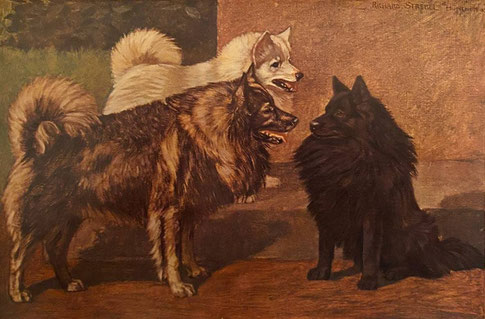
Since the thesis is still floating around that a wild-colored Spitz is basically nothing other than a Wolfspitz and that, as a result, the wild-colored Giant Spitz can simply be transferred to a Wolfspitz, here is an overview of the different colors of the large Spitz. While the coat color of the smaller varieties had no significance for breeding, the color distribution of the larger varieties of Spitz was originally based exclusively on their respective use:
The Wolfspitz as the largest representative of the breed has herding dog qualities, and is ideal as a guard dog. He was mainly widespread in the Rhineland and Westphalia. Its wolf-gray color offered him a good protection in the dark (he disappeared into the darkness), and since it is a little less likely to bark than his white, brown and black relatives, he caused unpleasant surprises for intruders of all kinds when he appeared in front of them completely unexpectedly - and unseen.
Black, gray and brown Giant Spitzes were mainly represented in southern Germany, where they drove strangers, vermin and predators out of the vineyards, mainly at night, unseen. Because of the dangerous nature of the work, they were considered to have the most aggressive and severity Spitz with the biggest vehemence.
The white Giant Spitz was mainly native to northern Germany and Westphalia. He watched over the farms, estates and manors but was also often used to herd livestock. To ensure that sheepdogs were not mistaken for wolves at night and were shot, they used to have their color matched to the color of the sheep.
It follows that the different colors of the large Spitzes are by no means insignificant, and the pure breeding of the large Spitzes - at least up to a certain point - was definitely justified. Given this background, it is all the more astonishing that a local group from the German Spitz Club explicitly invited new-colored (pied, wild-colored, "colorful") Giant Spitzes to a VDH-protected dog show - even though the new colors are not currently recognized by the breed standard. These dogs were then even be presented to the audience in the show ring. One can only be amazed - and also at the persistence of the breeders of the so-called "multicolored" Giant Spitzes. The alleged variety of colors of the Giant Spitz did not exist at all in the currently propagated masses in the past. Of course there were colorful Spitzes, but they were always in the minority
Conclusion
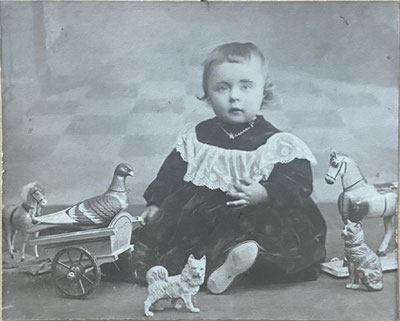
The German Spitz is an old German cultural asset - a robust breed that has always been indispensable for the common people, be it as a companion and guardian of their belongings, or as a playmate for children. One of them drove potatoes to the market - a Spitz sat on top. The rag dealer came driving along - the Spitz was sitting next to him. When the vegetable farmer's cart rolled through the village, there was a Spitz running behind it. Thanks to its versatility, the breed naturally ensured its spread and appreciation. Until now. In the meantime, the direction in which the German Spitz is being bred is tending more and more towards pure hobbyist façades that have little to do with the original dog of our people.
All of us who are attached to the old German Spitz type must definitely stick together now! Regardless of whether your heart beats for Wolfspitzes, Giant Spitzes or the smaller varieties: the direction of extreme, uncontrolled mixing of all varieties and colors will result in a single mess - in appearance as well as in nature. It is therefore immensely important that all Spitz varieties are preserved in their originality - regardless of buyer wishes, trends or your own monetary needs. It should therefore not be about improving the German Spitz or adapting it to any supposed modernity, but rather it should only be about preserving it as it has always been (good).
Well, folks now we just have to watch out for the Spitz!
Related articles:
[2] From “Der Wolfsspitz” by Britta Schweikl (p. 231)
[3] The Czechs have been crossing Wolfspitzes into the existing population of Giant Spitzes every few generations for years.
11.05.23











